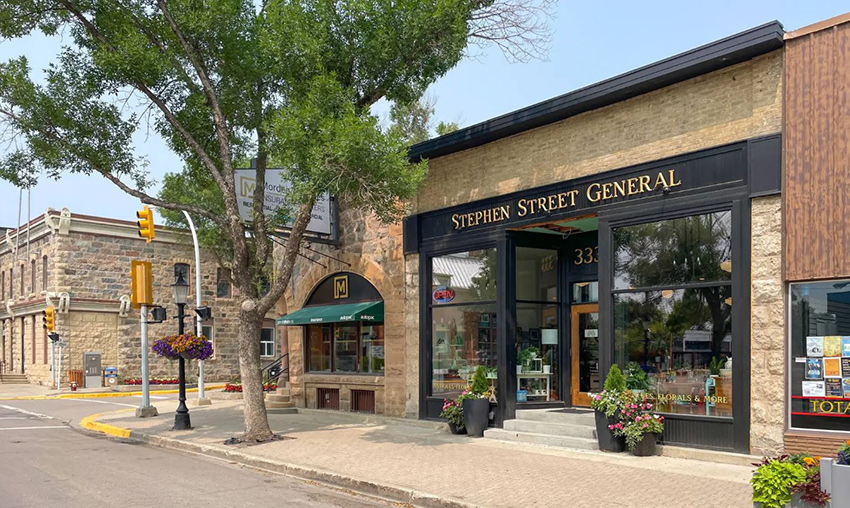By Brent Bellamy, Architect + Creative Director
Originally published in the Winnipeg Free Press
Imagine strolling through a great neighbourhood where the streets are lined with majestic trees and new houses sit alongside those that have stood for generations. The sound of laughter fills the air as children skip past you on their way to school.
On the commercial street at the end of the block, a bakery’s aroma entices you, but you continue. The unique storefront window displays draw you in and slow your pace. Entering your favourite coffee shop, the barista nods and starts your regular order. You head to the corner to enjoy your drink in a pocket park that just last night was filled with neighbours enjoying a local band.
This is a picture of urbanism. It’s what attracts people to live in dense, urban communities like Winnipeg’s Corydon area.
Image: Stephen Street General store in Morden. Principles of good urbanism can be successful from the largest cities to the smallest rural centres. Photo by Brent Bellamy.
Now consider that imagery in the context of a smaller community like Morden, Man.. It’s not hard to see the similarities.
The word urbanism conjures images of faceless and alienating cities, but its concepts strive to create places that are just as familiar to the idyllic small towns that create the backdrop of every Hallmark Christmas movie.
Climate change is making cities less livable. Inflation and housing costs are making them less affordable and a post-pandemic shift to working from home has opened new lifestyle options for many.
Smaller cities and towns are in a unique position to capitalize on these changes, attracting new residents and investment by offering a walkable, urbanist lifestyle that builds on the idea of small towns being the OG of 15-minute cities.
The traditional main street holds the key to unlocking this new opportunity. Many small-town main streets were lost to the same forces challenging big-city downtowns — big box stores, vehicle-oriented retail development and growth away from the centre. Reviving these traditional arteries can be the centrepiece of a unique, small town urbanist lifestyle.
Accepting that targeted density isn’t a bad thing is an important step in breathing new life into a main street. A vibrant commercial area needs people living within walking distance to provide a permanent market for the shops.
To encourage density, small towns can use zoning bylaws, development incentives and proactive marketing strategies to attract desirable projects to the centre. Main street density in the form of seniors’ housing provides a walkable lifestyle to people aging in the community they love. Mixed-use buildings and apartments can provide affordable housing options that help to retain a community’s young people looking for the connectivity that a vibrant main street can offer.
It’s also important to strengthen walkable links between surrounding residential neighborhoods and the commercial core. Narrowing large connecting streets and widening sidewalks, planting shade trees, and creating safe bike lanes can naturally draw people to the centre.
Creating a sense of place is vital to attracting people and business to the main street. Incremental improvements like painting building facades, planting trees, installing benches and public art, can snowball into larger successes. Creating new public space by closing streets to vehicles or transforming an open lot into a plaza can create a focal point for public connection and provide places to hold events and programming that attract people downtown.
Working collaboratively with residents, business and tourism associations, town councils and planning offices is critical to reviving a main street and sometimes the commitment of a few, or even just one person, can be impactful.
One of these people lives in Morden, where every day you can find Bevan Wiebe behind the counter of Stephen Street General, his antiques and collectibles shop. The store sits in a beautiful little building that he and his wife Sandra painstakingly restored, exposing the century-old brick, and recreating a beautiful wooden storefront with historic handcrafted detail.
The little shop looks like it’s been there for generations, but it has over the years moved from building to building along Morden’s Stephen Street, making way for new businesses, and acting as a catalyst to bring other buildings to life.
His first shop opened after restoring the former home of the Morden Chronicle, now the site of a local brewery and taproom. It moved across the street to a 1960s department store where a new façade was built and three storefronts created, one of which is a newly opened coffee shop. They also built a new two-storey building, set to the sidewalk with an attractive storefront, now housing a trendy salon, with two residential apartments above. The building is almost impossible to identify as a new building.
The architectural details and historic spirit of these developments that are connected directly to the sidewalk help create a sense of place along the street. The distinct character of each development attracts unique tenants and when combined with other urbanist ideas like streetscaping improvements, placemaking initiatives, strong planning policy and higher density mixed-use developments, they are creating a vibrancy in downtown Morden that is helping to retain young people, attract new visitors, residents and businesses.
Morden was fortunate to not have demolished its historic streetscape in the lean years, as many towns did, but the city is proving that the principles of good urbanism can be successful at all scales, from the largest cities to the smallest rural centres.
Brent Bellamy is creative director at Number TEN Architectural Group.


